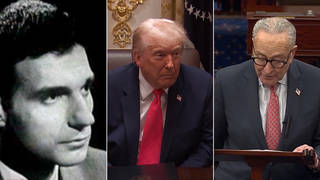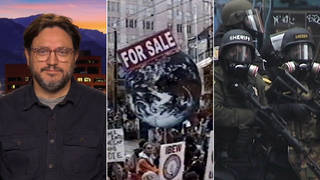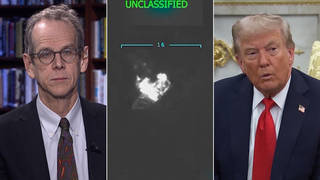
Topics
Sister Dianna Ortiz speaks about her abduction and torture by security forces in Guatemala in 1989, when she worked as a missionary among indigenous peoples. She testifies for a mock trial of Bush administration officials for breaking laws on torture held during the “Call for Justice Weekend” in September. [includes rush transcript]
The Call for Justice Weekend took place in September, organized by the Unitarian Universalists Service Committee. The weekend featured workshops, panel discussions and testimony by torture survivors from the Middle East, Latin America and the U.S. One of the featured events was a mock trial of Bush administration officials for breaking U.S and international laws regarding torture. Participants in the trial included Jennifer Harbury, who testified about her husband, Nobel Peace Prize Laureate Mairead Maguire of Ireland and Sister Dianna Ortiz.
In 1989, Sister Ortiz was abducted by security forces while working as a missionary among indigenous people in Guatemala. She was taken to a secret prison in the capital center and brutally tortured. She was questioned by Professor Margaret Montoya who is an attorney and longtime civil rights activist who teaches at the University of New Mexico.
- Dianna Ortiz, A Catholic nun who was abducted and tortured by security forces while working as a missionary in Guatemala.
- More information on Call for Justice Weekend Mock Trial Cast.
Transcript
AMY GOODMAN: We’re going to go now to hear some of the testimony of Sister Ortiz. She was questioned by Professor Margaret Montoya, who is an attorney and long time civil rights activist and teaches at the University of New Mexico. Sister Dianna Ortiz talked about the day she was kidnapped when she was questioned by the attorney.
SISTER DIANNA ORTIZ: I went with one of the sisters to the convent retreat center in Antigua, and I was praying in the garden when two men approached. One of them had a gun and said that if I did not go with them, that they would hurt the other people who were participating in the retreat. There was an opening in the back wall of the garden, and I was taken through that opening. I was put into a police car, blindfolded and put into or taken to the Politécnica.
MARGARET MONTOYA: Sister, what is the Politécnica?
SISTER DIANNA ORTIZ: It’s a large military installation, which is located near the United States Embassy.
MARGARET MONTOYA: Can you tell us what happened to you there?
SISTER DIANNA ORTIZ: I was taken to a downstairs cell. I was badly tortured and repeatedly raped.
MARGARET MONTOYA: Sister, are you able to tell us more about this?
SISTER DIANNA ORTIZ: I am. It’s very difficult. Those of us who have survived torture must relive all our torture every time we speak of it, and that’s one of the reasons why few of us do speak publicly.
MARGARET MONTOYA: Sister, tell us what you are able to.
SISTER DIANNA ORTIZ: They began by questioning me. Every time I answered a question, no matter what answer I gave, they burned my back with a cigarette. I had over one hundred and eleven cigarette burns on my back before it was over.
MARGARET MONTOYA: Sister, during this time, you were answering their questions?
SISTER DIANNA ORTIZ: Yes, but they burnt me anyway. After a while, I tried to give whatever answer they wanted to hear, even if it was not true. They showed me a photo of a woman, a woman I had never seen or met, and asked me if it was me. She looked nothing like me, but no matter how I answered, I was burned.
MARGARET MONTOYA: Sister, today we have seen the photographs from Abu Ghraib. I’m wondering, when you saw those photographs, what was your reaction?
SISTER DIANNA ORTIZ: I could not even stand to look at those photographs; neither could many of the other torture survivors, especially those of us from Latin America.
MARGARET MONTOYA: Can you tell us why it was difficult to look at those photographs?
SISTER DIANNA ORTIZ: Because so many of the things in the photographs had also been done to me.
AMY GOODMAN: At that point, Sister Dianna Ortiz broke down, but she continued to testify in this mock trial in Washington. Sister Dianna Ortiz, an American nun who went to Guatemala to work with women and children. The human rights attorney, Margaret Montoya, then asked Dianna Ortiz what things she saw in the photos of torture at Abu Ghraib that were done to her. Dianna Ortiz composed herself after breaking down and answered the question.
SISTER DIANNA ORTIZ: I was tortured with a frightening dog and also rats. And they were always filming — filming parts of the torture that occurred, parts of the torture that I was forced to participate in.
MARGARET MONTOYA: So why did they film you, Sister?
SISTER DIANNA ORTIZ: They were laughing while they were filming these horrible things and threatening that later they would show them to my friends and family or even publish them.
MARGARET MONTOYA: And what were your feelings about that?
SISTER DIANNA ORTIZ: It was unbearable. No matter what you tell yourself rationally, those threats haunt you for a lifetime. It’s part of the psychological torture of making you feel that it’s all somehow your fault, that you are to blame for it all, also that they can still find you and hurt you later on.
MARGARET MONTOYA: Is there more that you can tell us about?
SISTER DIANNA ORTIZ: There were other people in the clandestine cell, the clandestine prison, as well, and I could hear terrible screams. Many were killed. I saw some bodies. There were children, as well.
MARGARET MONTOYA: Who else was in the room while you were being tortured, besides the Guatemalan torturers?
SISTER DIANNA ORTIZ: After a while, there was — an American walked in.
MARGARET MONTOYA: Why do you think it was an American? Can you describe him for us?
SISTER DIANNA ORTIZ: He was taller than the Guatemalans. He was light-skinned and European looking. He wore an obvious curly brown wig and big sunglasses and had a light colored beard. And when he walked into the room and saw what was going on, he used a common word: 's — t.' When he spoke in Spanish to the torturers, he had an obvious American accent.
MARGARET MONTOYA: Do you remember what was said?
SISTER DIANNA ORTIZ: Yes. It was evident that he was upset. He ordered the men to stop the torture, telling them that I was a North American nun, and that my disappearance had become public, and it was because — my disappearance was beginning to cause an uproar.
MARGARET MONTOYA: And how did they respond?
SISTER DIANNA ORTIZ: They followed his orders, and they didn’t rape me again, and they left the room. I asked him if he was an American, and his answer was evasive. “Why do you want to know?” he asked me. I told him that he had used a word that was common in the United States. He, Alejandro, tried to help me put my clothes back on and eventually led me out of the building.
MARGARET MONTOYA: And then what happened?
SISTER DIANNA ORTIZ: The American, Alejandro, put me into his jeep and drove off, and during the ride he told me to forgive my torturers, telling me that they were all just trying to fight communism; if I didn’t, that there would be consequences. He reminded me that my torturers had made videotapes and had taken photographs of the part of the torture that I was most ashamed of. In perfect American English, Alejandro told me that if I didn’t forgive my torturers, he would have no other choice than to release the videotapes and the photos to the press. He also told me he was going to take me to see a friend at the U.S. Embassy. And at this point, the jeep stopped in traffic, and I jumped out and ran.
MARGARET MONTOYA: Is there anything else?
SISTER DIANNA ORTIZ: I tried speaking in English to him, and it was evident that he understood me, and after a while, he answered and spoke in English.
MARGARET MONTOYA: And then what happened?
SISTER DIANNA ORTIZ: I was certain that he was going to take me to be executed, so I jumped out of the jeep, as I mentioned earlier, and a woman recognized me from the news broadcast and took me in until I could call the sisters for help.
MARGARET MONTOYA: And at that point, did you leave Guatemala?
SISTER DIANNA ORTIZ: First, I went to the Maryknoll House in Guatemala City and then I was taken to the Vatican Embassy, and there I provided the authorities with a brief statement, never mentioning, in this document, the American, because that was the advice an Embassy official had given to one of the sisters and the advice that the lawyers who were assisting me had given me, as well. And it wasn’t until I came back to the U.S. that I began to speak publicly about the American, and in response, the U.S. government intensified a smear campaign against me. The Guatemalan government cooperated in this campaign, as well. I was labeled a liar, a crazy woman, even that I was a political strategist who was trying to influence Congress to cut off U.S. aid to the Guatemalan military.
MARGARET MONTOYA: Sister Dianna, can we go back to Guatemala for a moment? Are the locations of the torture cells known publicly?
SISTER DIANNA ORTIZ: No. The relatives of the disappeared, of course, search everywhere for their loved ones and have done so for many years now. We hear that certain places, like the Politécnica, have secret cells, but these are secret. The courts, the police, the families, they are never told and have no access.
MARGARET MONTOYA: And yet, this man with American accent and American features, he knew where to find you within mere hours of the news of your kidnapping?
SISTER DIANNA ORTIZ: Yes, he did. He did.
MARGARET MONTOYA: And he was able to walk in and walk around where you were being tortured?
SISTER DIANNA ORTIZ: Yes, he was.
MARGARET MONTOYA: And he and the Guatemalan torturers knew each other?
SISTER DIANNA ORTIZ: Yes. In fact, they called him Alejandro, though I do not know if this was his real name or not.
MARGARET MONTOYA: And he seemed to be giving orders?
SISTER DIANNA ORTIZ: Yes, and the torturers obeyed him.
MARGARET MONTOYA: They called him boss?
SISTER DIANNA ORTIZ: Yes.
AMY GOODMAN: Sister Dianna Ortiz, an American nun and Ursuline Sister who worked in Guatemala and was captured there by Guatemalan military, describing her experience. She spoke in Washington, D.C., at an event organized by human rights attorney, Jennifer Harbury, and the Unitarian Universalist Service Committee. We will link to the entire event as well as to the pieces around torture in this “Call For Justice Weekend.”












Media Options